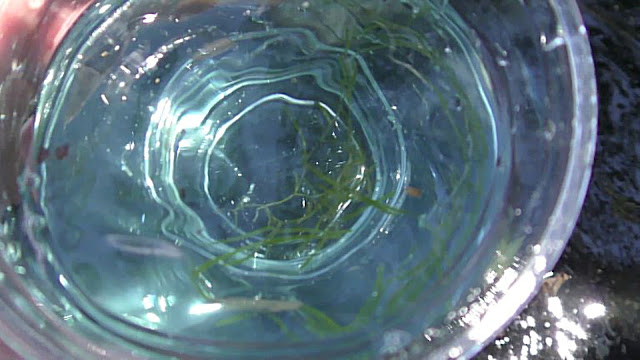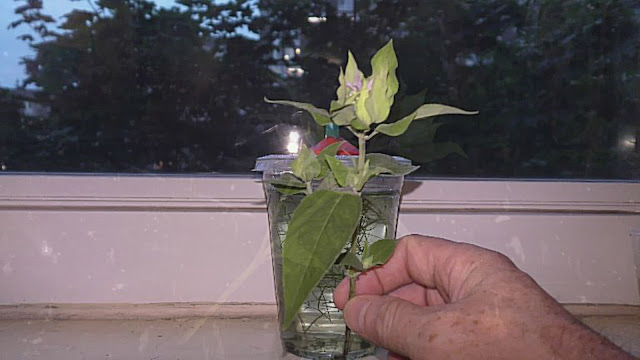This adventure starts at my favorite pond in Central park of NYC.
Grab a cup of water at your local shop before going to your local pond.
Drink the water, but save the cup.
All you need is a clear plastic cup with a lid and a straw.
Get a sample of water with some plants from the pond.
Here I got Leafy Pondweed...but any plants will do.
Even old tree leaves would do.
Though, live plants are the best.
Also, look for a couple pond snails like this.
They are great for our purpose.
The younger/ smaller snails the better.
Just 2-3 snails, no more than that.
And it's okay if you don't find snails.
In my experience, every sample of wild plants comes with some tiny critter.
So, look for a good bush of seaweed like this.
Snails and critters lay eggs and hide in thickets like this.
Put it in your cup and take a close look at it.
I think it's too much grass for my cup.
So, I just rinse the plants in the cup to separate whatever critters could be there from the plants.
Now, look again at the plants.
Here you can see some eggs attached to the plant!
I keep this plant in the cup.
The other plants can go back to the pond.
Though, I am sure it also full of some critters ;)
Cover the cup with the lid and take it home.
A plastic straw of any diameter will do.
Cut about 2-3 cm long piece of the straw.
Insert the piece of the straw into the lid.
I use plasticine to seal the hole in the lid around the straw.
Make a ring out of plasticine.
Put the ring on the straw.
Press the plasticine to the lid and the straw to seal the holes.
Plasticine is waterproof and it never dries.
We just made a base for an aquarium garden ;)
Put the lid on the cup.
Make sure the bottom end of the straw stays above the water level.
This allows for air circulation while reducing water evaporation.
I like to put cuttings of flowers or plants in the straw.
It looks pretty and cool, but it is not necessary for this project.
I use flowers in this demonstration to show possibilities for you to explore.
That is how it looks on July 1st 2019 Notice the water level.
With flower or not, the important things in this setup are the tiny aquatic critters and common green algae.
Algae feeds on organic waste produced by critters and critters feed on algae.
Natural sunlight and atmospheric air is all it takes to make this system self-sustainable.
Put it on a windowsill and... Congratulations! We have made a simple self-sustaining aquarium.
This particular cup gives water a slightly blue tint.
Looks pretty to me.
The time-lapse recording shows the pond snails roaming for algae.
On July 5th, I pick a flower of wild Bergamot for my aquarium.
And again, the flower is just for fun :)
Trim the stem and remove bottom leaves.
Put the flower in the aquarium.
Wait for the sun to shine on it to see the beauty!
Here we go.
Take a look at this, now one week old, self-sustaining aquarium.
There are pond snails.
They have already laid eggs.
I see nematodes and seed shrimp.
They are very common critters found in ponds and lakes.
I get them with all my wild samples.
It is a beautiful ecosystem.
Here is a time-lapse recording of the flower.
You may notice some tiny critters crawling on the flowers.
All wild samples come with some critters.
As small as they are, they play a fundamental role in keeping our environment sustainable.
I remove the flower on July 6th to make room...for roses.
Remove leaves.
Trim the stems.
Notice the water level remains the same.
I like flowers.
Flowers live in different time dimension.
There is some magic in it.
This ecosystem has the potential to self-sustain all year around.
And I have it done previously in similar setups.
It's a perfect study and discovery tool for science classroom projects.
Nature is full of surprises.
And here is a surprise I found in this aquarium 2 weeks after setup, on July 12th 2019.
Here you can see a nymph moving around baby snails.
This nymph looks different from dragonfly and damselfly nymphs that I had previously.
I have no idea what insect it is, but it is a nymph...and nymphs feed on other critters including nymphs.
Here are probably snail eggs.
And there are couple smaller nymphs.
The big nymph most likely would eat them.
This aquarium is too small to provide enough food, like seed shrimp and nematodes, for this nymph to feed on.
In search for food, the nymph hunts down every small algae feeder it could find in this small tank.
The water gets green as a result of it.
Only snails protected by shells from the nymph remain active algae feeders.
Though snails only pick algae from the walls, leaving floating algae unchecked.
Nymphs move fast when they have to.
And they can swim.
You can see guts through the semi transparent body of this nymph.
And what I see is a very hungry nymph.
This self-sustaining aquarium is too small to sustain a predator like this nymph.
I do not see any seed shrimp or other nymphs left in this aquarium as of July 16th.
And it looks like this nymph could not find them either.
Figuring out a food chain for a small size self-sustainable aquarium with fish is even more complicated.
The nymph died on July 20th - about 3 weeks after initial setup.
The body of the nymph would eventually become food for new generations of snails and whatever other small critters may have survived the hunt.
Time-lapse recording on July 28th reveals some seed shrimp and a bunch of snails happily coexist in this self-sustaining aquarium for almost a month now :)
Here is a close-up view of snails and seed shrimp.
Seed shrimp looks like a small roaming around dot.
Basically the system is back to the quiet before-the-nymph stage.
The water level does not change and there is no reason for it to change significantly for the next year or so.
A sign advertising free yoga class got my attention.
There is a common garden snail on it!
Garden snails, caterpillars, and such make interesting pets that we can keep on top of the aquarium!
Let's get one garden snail.
And take some cuttings of plants growing nearby.
Those are most likely to be the source of food for the snail.
So, here is my self-sustaining aquarium with many tiny pond snails as of August 4th.
The water level is the same and I see strings of filamentous algae growing.
Alright, let's set up an aquarium garden for the garden snail.
Trim cuttings of the plants to fit through the straw into the water.
The ends of the plants should be in the water for them to stay fresh longer or even to keep growing.
Plants certainly would suck the water from the tank, reducing lifespan of our self-sustaining aquarium.
Nevertheless, there should be enough water even in this cup sized tank for most plants to last through the Summer ;)
Put the garden snail on the base next to the plants.
I spray the plants, the base, and the snail with dechlorinated water.
Use an empty cup of the same size as the aquarium to cover the plants with the snail.
Ta-dah!
We have made an aquarium garden!
I put links in the description to the video for you to check my previous videos for details about care for snails, slugs, and caterpillars.
So here we have a number of cool projects anyone can do basically in a plastic cup.
How about that :)
It looks simple and yet it allows to learn first hand about Nature and to make your own discoveries.
I use similar setups for growing land plants underwater, for growing succulents in water, and taking baby steps in building my self-sustaining aquariums.
Have fun and happy discoveries :)





























































































































No comments:
Post a Comment